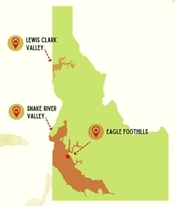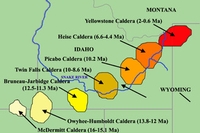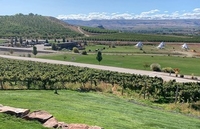When people think of wine destinations in the United States, they consider sites in California, Oregon, Washington and maybe New York and Michigan. Few thoughts turn to vineyards in Idaho, but there are indeed vineyards and wineries in the Gem State, and they are well worth investigating. Idaho now has three AVAs with over 75 wineries.

AVAs of Idaho
Most of Idaho’s vineyard acreage is in the western Snake River Valley, west of Boise. The geologic history of the region has strongly influenced the land we know today. For the past 16 million years, the North American continental plate has been moving over what is known as the Yellowstone Hotspot – a plume of molten rock that rests near the earth’s surface and causes volcanic eruptions. Currently, the plume is under Yellowstone National Park but 12 million years ago it was in western Idaho, causing large volcanic eruptions and fracturing the earth’s surface with faults. Some of these faults border the down-dropped block, or graben, through which the Snake River now flows.

Movement of the Yellowstone Hotspot Volcanics Over Time
Most of the volcanic and tectonic activity had passed to the east by around 9 million years ago, but the stage was set for subsequent events. For several millions of years, the Snake River Valley was inundated by the waters of ancient Lake Idaho, which stretched some 200 miles at its greatest volume. Several thousands of feet of sediments were deposited in and around the lake. These sediments, interspersed with volcanic soils, comprise the vineyard soils of the Snake River Valley today.
Idaho’s wine history is similar to that of other western states. European emigrants brought their winemaking traditions and skills with them to the new world. The first recorded vines were planted near Lewiston in 1864. There was a thriving regional wine industry until 1916, when Idaho began Prohibition four years before it was enforced nationwide. That ended the Idaho industry, and after the repeal of Prohibition in 1933, the nation was in the throes of the Great Depression, followed by World War II and the postwar recovery years.
Thus, it was not until the 1970’s that the modern Idaho wine industry had its beginnings. The first vine plantings in the Snake River Valley were in 1972 and the Ste. Chapelle Winery opened with some fanfare in 1975 on what is now known as the Sunnyslope Wine Trail. A slow growth process has continued and, while the production is still small, there are many promising highlights to today’s Idaho wine scene. The Snake River Valley AVA was established in 2007, comprising some 8,000 square miles of Idaho and Oregon. The Eagle Foothills AVA, within the Snake River Valley was established in 2015 and the Lewis-Clark Valley AVA in northern Idaho was approved in 2016.

Vineyards in the Snake River Valley AVA
The Sunnyslope Wine Trail lies near Caldwell Idaho, about a half-hour’s drive from Boise. It encompasses 19 wineries and gives a good cross-section of what is happening wine-wise in the Snake River Valley AVA. The bulk of the state’s vineyards are here. Many of the Idaho wineries buy grapes from this area even if the winery is located elsewhere.
There is also an attractive urban wine corridor along the Boise River in Boise itself and adjacent Garden City. Its an easy way to sample what is happening with some of the best and most innovative Idaho wineries. Throughout my brief journey to the state, I found excellent versions of white varieties like Chenin Blanc, Verdejo and Grüner Veltliner along with the more familiar Chardonnay, Riesling and Sauvignon Blanc. Among red wines, I was impressed with some bottlings of Tempranillo, Sangiovese, Syrah and Malbec.
Some Highlights of My Tastings:
2021 Sawtooth Winery Snake River Valley Chenin Blanc: Floral and fresh with apple, pear and tropical fruit notes. Bright, clean and refreshing flavors with juicy fruit and a zesty, dry finish.
2020 Ste. Chapelle Winery Snake River Valley Petite Sirah: Not as dense and tannic as California versions of this variety. Ripe and round with cherry and blackberry fruits enhanced by a touch of black peppery spice.
2020 Scoria Vineyards Snake River Valley Estate Petit Verdot: Scoria is named for the eponymous volcanic rock that is evident in their vineyards. This Petit Verdot is deep and rich with black cherry and blackcurrant fruits backed by olive, herb and toasty oak nuances.
2021 Indian Creek Winery Snake River Valley Reserve Pinot Noir: Pinot Noir is not widely grown in Idaho, but Indian Creek is away from the river on caliche/lime soils. The Pommard clone of Pinot Noir is grown here, and the 2021 Reserve shows pure, lively ripe cherry and raspberry fruit with hints of herbs and spice.
2022 Cinder Wines Snake River Valley Verdejo: A lovely rendition of this Spanish white variety. Scents of flowers, peach, rainier cherry and tangerine are enhanced by hints of creaminess and spice. I will be very interested in tasting what Idaho vineyards can do with this aromatic variety.
2021 Telaya Wine Co. Snake River Valley Turas: An impressive blend of Syrah (46%), Malbec (13%), Mourvèdre (12%), Merlot (12%), Sangiovese (8%) and Cabernet Sauvignon (8%). Rich, layered and complex, this beautiful red offers black cherry, blackberry and red cherry fruits underscored by smoky/bacon nuances plus herb and spice elements.
At Telaya, I was also pleased with a dry Chenin Blanc, a Chablis-style Chardonnay, and a pure and lively Sangiovese. A sampling of a 2016 Telaya Mourvèdre revealed a maturing, but still supple and smooth red with floral, tea leaf, red apple and strawberry hints plus delicate layering of flavors with a touch of earth and forest floor.
It's an easy trip to visit the Idaho wine country. Many wineries are easily accessible from Boise and the urban wine scene is thriving as well. There are fewer wineries in the Lewis-Clark Valley AVA in the north, but this is a fascinating area where the Snake River joins the Columbia River. The elevation is lower here and there is promise for Cabernet Sauvignon and other late-ripening varieties. There are Idaho wineries farther east along the Snake River as well in the far north of the state, near lakes Coeur d’Alene and Pend Oreille. Idaho is a beautiful state to visit, and you can add wine country experiences to you next journey.